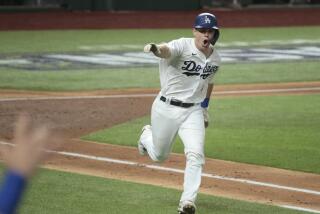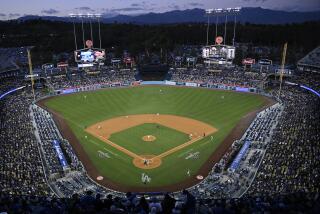An ad among the ivy
- Share via
Ivy League or bush league?
Chicago Cubs fans were debating that question this week after their team broke with tradition and agreed to sell advertising space on Wrigley Field’s fabled ivy-covered outfield walls.
The deal will allow sports apparel and footwear manufacturer Under Armour to place its logo on two access doors in the walls that are covered with ivy first planted in 1937 by Bill Veeck. The signage, along with a logo behind home plate and other advertising elements, will be in place for the Cubs’ home opener with Houston on April 9. The Cubs reportedly were the last big league club without any ads on its outfield fences.
Under Armour and the Cubs did not release financial terms of the deal that will include a pair of 7-foot by 12-foot Under Armour logos to be painted on the doors. The deal was driven by the team’s ongoing effort to find “alternative and creative revenue streams,” a Cubs official said. The Cubs and the Los Angeles Times are both owned by Chicago-based Tribune Co.
Under Armour, which already has advertising inside Baltimore’s Camden Yards and Fenway Park in Boston, will use the new signs to market its growing line of baseball cleats and sports apparel. The company knows that some fans will be irritated. “The Cubs will tell you what happened when they played the first night games,” said Under Armour Vice President Steve Battista. “But it’s all part of putting a winner on the field.”
If past tinkering with the ballpark’s historic character is any indication, fan anger probably won’t last. Wrigley partisans erupted in 1988 when the Cubs added night games, but the late-starting games soon grew popular.
The anger over the outfield signs was evident Thursday on the Internet. “There is just something inherently wrong about ads being placed among the ivy at Wrigley Field as part of some lame marketing ploy,” one blogger wrote. Sports marketers, however, weren’t surprised by the Cubs’ decision.
“It is in the natural course of sports marketing that the ivy is falling,” said Shawn Bradley, chief operating officer of the Denver-based Bonham Group Market Research Company. “There is a very elite, select group that, at this point, has remained free of sponsor or advertising clutter, and Wrigley had been one of them.”
Though such events as the Olympic Games and the Masters golf tournament in Augusta, Ga., are largely free of advertising, the trend long has been in the other direction.
“Given that the Cubs committed to $300 million in salary this past off-season, they are looking to boost any and all revenue streams,” said Patrick Rishe, an economics professor at Webster University. “I doubt seriously that the average fan is going to say, ‘Damn those Under Armour people for ruining a tradition.’ ”
Baseball history suggests that ballparks and advertising go together like a hit-and-run play. Fenway Park’s Green Monster, for example, used to advertise such jingles as “Avoid 5 o’clock shadow” (Gem Blades) and “The Red Sox Use It” (Lifebuoy). The Green Monster earned its sobriquet in 1947, when crews painted over the slogans with green paint. The current Red Sox owners continue to sell ads on the fabled wall in left field.
Another celebrated outfield ad during the 1940s and 50s was the Abe Stark clothing store sign at Ebbets Field that read “Hit Sign, Win Suit.” Brooklyn Dodgers who hit the right-center field ad with a fly ball got a free suit from the store.
The merger of baseball and advertising hasn’t always gone smoothly. Last summer, the little-known independent Golden Baseball League irritated purists by selling advertising space on its jerseys. In 2004, Major League Baseball abandoned a plan to glue Spider-Man movie logos on first, second and third base. Earlier, MLB drew considerable heat by allowing casinos to install signs.
Sports marketers gravitate toward ballparks and arenas because they provide a captive audience and potentially valuable television exposure.
Last season, for example, the rotating advertisements behind home plate at Angel Stadium of Anaheim were televised for an average of 2:06 minutes during each half-inning. That exposure was worth $18,900 for each half-inning, according to Ann Arbor, Mich., market research firm Joyce Julius & Assoc. Two outfield signs, like those to be added in Wrigley Field, could generate an equal amount of on-screen time during an entire game.
Bradley suspects that any bruised feelings will ease should the 2007 Cubs win the World Series: “Winning can cure an awful lot of things.”
*
More to Read
Go beyond the scoreboard
Get the latest on L.A.'s teams in the daily Sports Report newsletter.
You may occasionally receive promotional content from the Los Angeles Times.










